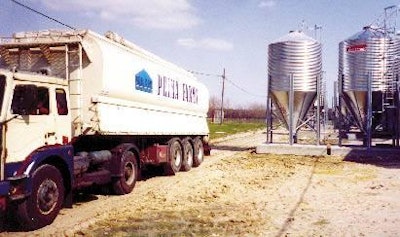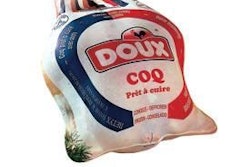
A proposed merger of US-based giants has left ContiGroup of the USA poised to gain an even higher profile in the pork and poultry industries internationally. Subject to a possible Justice Department ruling on competition grounds, the merger deal would make ContiGroup the largest single shareholder in the world's biggest pigmeat integrator, by joining together Smithfield Foods and Premium Standard Farms (PSF) to create a combined business with a total of 1.02 million sows on US sites and processing over 30% of all pigs slaughtered in American abattoirs, besides enterprises in Latin America and Eastern Europe.
Perhaps you recognise the group better as Continental Grain Company, the name by which it was known until 1999. Founded as a family-owned business in Belgium in 1813 and today one of the largest privately-held companies in the USA, since 1998 ContiGroup has owned 51% of PSF as part of a corporate strategy to be a major player in meat proteins. The terms of the takeover proposal would swap that shareholding for shares in Smithfield Foods. Additionally, ContiGroup is considered in 6th place for size among American poultry processors with 13 plants in operation and its extensive foreign activities include interests in 15 feedmills in China. Within the USA it was already working with Smithfield Foods in a joint venture called Five Rivers Cattle Feeding.
PSF this year had described itself as producing 4.5 million pigs annually from sites in the US states of Missouri, Texas and North Carolina besides operating plants in Missouri and North Carolina with capacity for processing 4.6 million pigs/year. Sources have estimated that PSF units contain some 225 000 sows. The company created in 1988 is now considered second nationally on sow numbers and Number 6 for pork processing. Accounts for fiscal year 2006 revealed net sales of US$919.5 million and a 39% annual growth of pork exports to Japan, Canada and Mexico alongside hopes of developing in Latin America and China.
Smithfield Foods hardly needs an international introduction. From roots in 1936 nurtured first by Joseph W. Luter Snr and later by his son Joseph Luter Jnr, it has become beyond doubt the largest producer/processor of pigmeat in the world. Its American production operations spread across the US states of Virginia, North Carolina, Missouri and Utah with affiliates including Carrolls Foods, Murphy Family Farms, Vall Inc and Alliance Farm. It runs about 800 000 sows in the USA plus a total of 186 000 sows in Mexico, Poland and Romania, although it decided this year to sell its share of a 14 000-sow Brazilian venture amid claims that this depended too much on Brazil's pork exporting potential. Smithfield's 7 American slaughter plants can process 27 million pigs/year, of which about 14 million are produced on units in the integration's network.
In the group are such US meat product brands as Patrick Cudahay, John Morrell, Farmland, Cumberland Gap, Gwaltney and Stefano Foods. Externally it has subsidiaries or joint ventures for meats in China, France, Mexico, Poland, Romania and Spain. Recent purchases have included the US hams business of ConAgra Foods. In western Europe it recently formed Group Smithfield from the newly acquired European processed meat operations of Sara Lee. Fiscal 2006 sales (12 months to end of April 2006) for Smithfield Foods totaled US$11.4 billion.
The agreement between the 2 companies therefore would see the USA's second-largest pork producer and sixth-largest pigmeat processor, PSF, being acquired by the country's biggest in pig production and marketing. The offer agreed by their boards of directors has Smithfield buying PSF by paying US$693 million in cash and stock while assuming US$117 million of PSF's debt. Each PSF share will be coverted into the right to receive 0.678 Smithfield shares plus US$1.25 in cash. ContiGroup, which today holds 38.8% of PSF shares, has backed the transaction.
There are some side notes concerning genetics. In 1990 Smithfield acquired the exclusive rights to the genetic lines of Britain's National Pig Development Company (NPD). From this source it established Smithfield Premium Genetics to provide companies in the group with lean-generation pork genetics for their commercial pig production. It has also taken a minority shareholding in British breeder ACMC. Breeding stock suppliers to PSF include PIC and Genetiporc, with some boars from other international seedstock operators.
The merger candidate companies differ at present in that Smithfield produces only about half of the pigs it processes each year, whereas PSF's plants hardly buy on the open market. But the takeover would bring some modern further-processing plants into the Smithfield universe while also extending its ability to develop in processed meats, which it has called the profit area compared with fresh pork. The merged businesses stand to be producing 20% of all pigs raised in the USA and, at 120 000 pigs/day, they will own 28% of the national slaughtering capacity.
Others note that a post-merger situation would leave the Top 5 US operators controlling some 1.925 million sows of the 6 million sows in the USA. Critics have said the market power of the combined companies could threaten the independence of family farms, with Iowa Democrat Senator Tom Harkin calling for a Justice Department review because the agreement announced "involves a very substantial change in the structure, vertical integration and degree of consolidation in the US pork industry". Iowa Republican Senator Charles Grassley, in a letter to the anti-trust division of the Justice Department (DOJ), said the merger would hurt independent farmers. The findings from any official review may not be known until early next year, but commentators have insisted it is unlikely DOJ lawyers will block the sale. More possible, they suggest, is that the candidate enterprises could be required to sell off some of their operations. Termination fees in the event of the deal being scrapped would be substantial; sources talk of a US$1 billion bill for Smithfield and over US$27 million for PSF.
Good for Smithfield? The group stands to consolidate its lead in pork production/processing, putting it beyond the reach of any competitor. Further, it would strengthen its home base on the east coast of the USA, especially in North Carolina, while increasing influence in Missouri alongside the established presence of its affiliate Murphy Family Farms. The slaughter/process plant run by PSF in Milan, Missouri, is called state-of-the-art and an active exporter. Smithfield could spread its Premium Genetics seedstock through the existing PSF system. Eventually this could exclude other breeders from access to over 15% of the national herd.
A Smithfield spokesperson acknowledged that the merger would represent more consolidation, but argued that controlling pigs from pen to processing plant allowed the group to meet customer calls for traceability and product safety in terms of knowing where the pork came from and how it was produced.
Good for ContiGroup? Despite almost 3 years of profit in the American pork industry, PSF has recorded a somewhat lacklustre performance in its recent financial results from both production and processing. There were also arguments for increased investment. PSF has 1200-sow modules with on-site nurseries that were built in the late 1990's. New farms are being constructed in the size range 4800-5000 sows or bigger in order to gain extra economies of scale and use improved technology. More general factors also enter the scene, such as the uncertainties over future feed prices caused by the USA's expansion of ethanol production from maize and the disease difficulties in US sow herds due to the porcine circovirus PCV2. Additionally, of course, the obtaining of planning permits and the opposition of neighbours become ever more potent hardships for big producers.
What effects for the US pig industry? In some ways the potential impact looks small, as the size of the national herd remains the same. Analysts say that pig prices are unlikely to be affected by this merger and overall profitability should stay good for a further year. More important factors bearing on price are the ethanol/feed issue, the strength of the pork export market and the demand for pigmeat from US consumers, as well as escalating energy costs.
Also called resistant to change is the situation on animal welfare, in which sows are confined in gestation stalls and farrowed in crates while weaned pigs go into fully slatted grow/finish housing. Although there is great awareness of animal welfare pressures from food companies such as McDonald's, so far this has not produced much change on the ground. But the merger may encourage some smaller producers to consider niche market opportunities, some related to welfare, that would involve selling pigs to slaughter/process plants certified by the wholesaler or retailer.
Certain predictions can be made with even greater certainty, among them that the large-scale confinement pig units in the USA will continue to act as a magnet for immigrants from Mexico and Central America who already provide a significant part of the labour for daily chores on farms. Training schemes will increase, with visual aids and language skills prominent in them.
It is clear, too, that the combined Smithfield-PSF operation would become the largest single contributor to the check-off funds received by the National Pork Board as its financial base. According to one estimate, the newly merged companies could find themselves paying the board between US$10-12 million per year. But reassurances can be heard already, not least that joint research funding will continue for investigations into areas such as pollution and odour control which have enormous implications for the whole industry.
(Reporting by Keith Thornton and Peter Best with acknowledgement to information and comments from other contributors.)

















